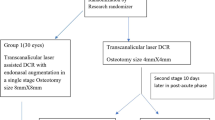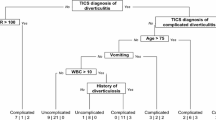Abstract
Purpose
We aimed to show the outcome of very early endoscopic dacryocystorhinostomy (VE-EDCR) in a routine pool of patients with acute dacryocystitis (AD) and abscess formation compared with the standard late external dacryocystorhinostomy L-ExDCR.
Methods
This was a prospective nonrandomized comparative study conducted from June 2013 to March 2016. Patients with AD and abscess formation were referred to our oculo-facial clinic in a university-based hospital. All patients received systemic antibiotics and were assigned to either of treatment groups. Patients in group 1 underwent late external transcutaneous DCR (L-ExDCR) and group 2 underwent EDCR within 3 days after first visit, named VE-EDCR. Primary outcome measure was success of surgery.
Results
Forty-one eyes of 41 patients with acute suppurative AD, were included from June 2013 to March 2016. Twenty-two patients underwent VE-EDCR and 19 underwent L-ExDCR. Mean age of patients was 43.41 (SD = 19.84, range 14–98) years. Mean follow-up was 14 (SD = 2.4) months. Anatomic, functional, and overall success in L-ExDCR and VE-EDCR groups were (89.5 and 86.4%, p = 0.99) (89.5% and 86.4%, p = 0.99) (89.5% and 81.8%, p = 0.66) respectively. Mean duration of cellulitis in VE-EDCR and L-ExDCR were 8.00 (SD = 4.63) and 16.11 (SD = 11.58) days, respectively (p = 0.027). No remarkable adverse event was found.
Conclusions
Success of very early endonasal endoscopic DCR is comparable with the traditional late external DCR. Duration of cellulitis is shorter in VE-EDCR. This therapeutic approach can be considered in patients with acute suppurative dacryocystitis.
Similar content being viewed by others
Login or create a free account to read this content
Gain free access to this article, as well as selected content from this journal and more on nature.com
or
References
Roithmann R, Burman T, Wormald PJ. Endoscopic dacryocystorhinostomy. Braz J Otorhinolaryngol. 2012;78:113–21.
Massaro BM, Gonnering RS, Harris GJ. Endonasal laser dacryocystorhinostomy. A new approach to nasolacrimal duct obstruction. Arch Ophthalmol 1990;108:1172–6.
McDonogh M, Meiring JH. Endoscopic transnasal dacryocystorhinostomy. J Laryngol Otol. 1989;103:585–7.
Wormald PJ, Kew J, Van Hasselt A. Intranasal anatomy of the nasolacrimal sac in endoscopic dacryocystorhinostomy. Otolaryngol Head Neck Surg. 2000;123:307–10.
Tsirbas A, Wormald PJ. Mechanical endonasal dacryocystorhinostomy with mucosal flaps. Otolaryngol Clin North Am. 2006;39:1019–36.
Lee TS, Woog JJ. Endonasal dacryocystorhinostomy in the primary treatment of acute dacryocystitis with abscess formation. Ophthalmic Plast Reconstr Surg. 2001;17:180–3.
Madge SN, Chan W, Malhotra R, et al. Endoscopic dacryocystorhinostomy in acute dacryocystitis: a multicenter case series. Orbit 2011;30:1–6.
Bell BG, Schellevis F, Stobberingh E, et al. A systematic review and meta-analysis of the effects of antibiotic consumption on antibiotic resistance. BMC Infect Dis. 2014;9:13.
Davey P, Marwick CA, Scott CL, et al. Interventions to improve antibiotic prescribing practices for hospital inpatients. Cochrane Database Syst Rev. 2017;2:CD003543.
Wu W, Yan W, MacCallum JK, et al. Primary treatment of acute dacryocystitis by endoscopic dacryocystorhinostomy with silicone intubation guided by a soft probe. Ophthalmology. 2009;116:116–22.
Li EY, Wong ES, Wong AC, et al. Primary vs secondary endoscopic dacryocystorhinostomy for acute dacryocystitis with lacrimal sac abscess formation: a randomized clinical trial,". JAMA Ophthalmol. 2017;135:1361–6.
Saha R, Sinha A, Phukan JP. Endoscopic versus external approach dacryocystorhinostomy: a comparative analysis. Niger Med J. 2013;54:165–9.
Joshi RS, Deshpande AS. Success rate of conventional dacryocystorhinostomy in post-acute dacryocystitis compared to endonasal dacryocystorhinostomy in acute dacryocystitis. J Ophthalmic Vis Res. 2017;12:290–5.
Rabina G, Golan S, Neudorfer M, et al. External dacryocystorhinostomy: characteristics and surgical outcomes in patients with and without previous dacryocystitis. J Ophthalmol 2013;2013:287524.
Amadi AJ. Endoscopic DCR vs external DCR: What's best in the acute setting? J Ophthalmic Vis Res. 2017;12:251–3.
Morgan S, Austin M, Whittet H. The treatment of acute dacryocystitis using laser assisted endonasal dacryocystorhinostomy. Br J Ophthalmol. 2004;88:139–41.
Jain S, Ganguly A, Singh S, et al. Primary nonendoscopic endonasal versus delayed external dacryocystorhinostomy in acute dacryocystitis. Ophthalmic Plast Reconstr Surg. 2017;33:285–8.
Naik SM, Appaji MK, Ravishankara S, et al. Acute dacryocystitis with abscess: endonasal dacryocystorhinostomy, the primary treatment of choice. Clin Rhinol. 2012;5:107–13.
Duggal P, Mahindroo NK, Chauhan A. Primary endoscopic dacryocystorhinostomy as treatment for acute dacryocystitis with abscess formation. Am J Otolaryngol. 2008;29:177–9.
Ali MJ, Joshi SD, Naik MN, et al. Clinical profile and management outcome of acute dacryocystitis: two decades of experience in a tertiary eye care center. Semin Ophthalmol 2015;30:118–23.
Author information
Authors and Affiliations
Corresponding author
Ethics declarations
Conflict of interest
The authors declare that they have no conflict of interest.
Additional information
Publisher’s note Springer Nature remains neutral with regard to jurisdictional claims in published maps and institutional affiliations.
Rights and permissions
About this article
Cite this article
Pakdel, F., Soleimani, M., Kasaei, A. et al. Shifting to very early endoscopic DCR in acute suppurative dacryocystitis. Eye 34, 1648–1653 (2020). https://doi.org/10.1038/s41433-019-0734-2
Received:
Revised:
Accepted:
Published:
Issue Date:
DOI: https://doi.org/10.1038/s41433-019-0734-2
This article is cited by
-
Acute dacryocystitis: changing practice pattern over the last three decades at a tertiary care setup
Graefe's Archive for Clinical and Experimental Ophthalmology (2024)
-
A case report of exophytic nasal papilloma with acute dacryocystitis as the first symptom
BMC Ophthalmology (2021)



